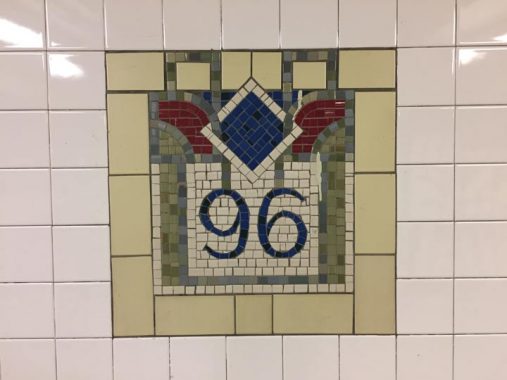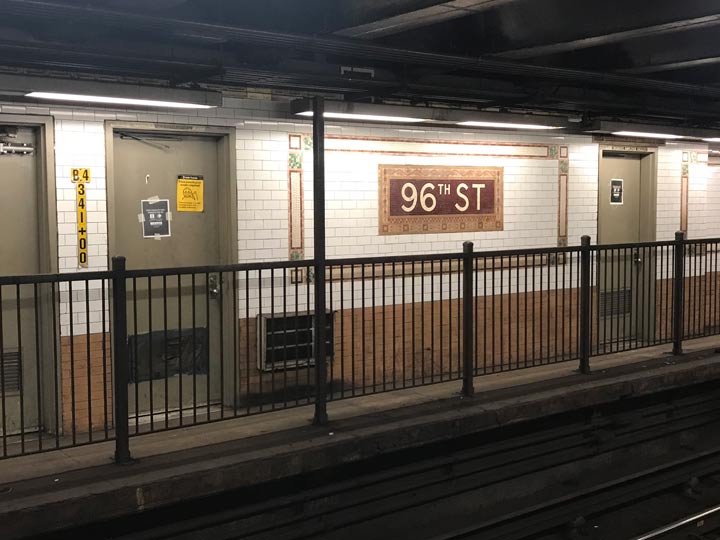
96th Street is one of the Original 28 IRT subway stations that opened on October 27, 1904 between the old City Hall station and 145th Street, #1, 2, 3 trains stop here, and this is your last chance to transfer from the express service to the local if you wish to proceed up Broadway toward Washington Heights, Inwood, Marble Hill and Riverdale; stay on the #2 and 3, and you’ll tunnel beneath Central Park and go up Lenox/Malcolm X Boulevard in East Harlem. I consider it something of a design flaw that express tracks couldn’t be placed under Broadway north of here, but perhaps there were technological/budgetary problems with that in 1904.
Like 72nd Street, there are island platforms, but there is the added attraction of two disused short side platforms. From 1904 to 1957, motormen, sorry, train operators opened doors on both sides, and there were exits on the center and the side platforms. (A hallmark of the original IRT is that it was built very close to the street, and the IRT advertised minimal steps to the street, unlike the old els, where Olympic-level stair climbing was the norm in the days before widespread elevators and escalators. Thus, Old Sol can illuminate some Broadway el stations all by himself.)
According to Joe Brennan at his invaluable Abandoned Stations, the 96th Street side platforms were disused not when the station was lengthened (that doomed the old 91st Street station) but when the Transit Authority introduced new cars that made it inconvenient for train ops from opening both sets of doors.
Nevertheless, that hasn’t stopped the MTA from installing safety strips on the side platforms (just in case they ever want to restore service), though they did add fences in the 1980s, just so no one is fooled into thinking you can get off or on there.


The original 96th Stret tilework can be seen on the side platform, but here’s a pair of commendable new mosaics installed during station renovations a few years ago.
As always, “comment…as you see fit.” I earn a small payment when you click on any ad on the site.
6/2/21


7 comments
I used to travel the 6 train. It also stopped at 96th.
6th and Lexington.
Kevin, permit me to add some additional details about the 96th-Broadway IRT station, because for the first fifty-plus years of my life that specific corner of the Upper West Side had a key role in my existence (I’ll spare the details). I used that station on a regular basis, and I still “drop by” occasionally to see it. It has had three different iterations, and I’ve seen them all. The material in this writeup is adapted from Chapter 15 in my book From a Nickel to a Token.
The original layout included a pair of short side platforms for the local trains, which originally were 5 cars long. Stairs led directly to the street from those platforms and locals opened doors on both sides to permit express train passengers to walk through and then go right upstairs. Passengers who wanted direct access between the street and the express platforms had to use an undergrade crossover at 96th St. that connected all four platforms and the street stairways.
In 1957, the Transit Authority embarked on a massive reconstruction of the IRT West Side Line between Times Square and 96th Street. The work was based on reworking the train service patterns at 96th Street, where the branch to/from Lenox Avenue and East Bronx diverges from the upper Broadway and Northwest Bronx branch.
Originally four separate train services ran at 96th Street – in typical IRT style they were designated by name only, as today’s numbers did not appear till the early 1950s, well after the IRT was absorbed into the NYC Board of Transportation. Two services originated on Upper Broadway, the Broadway-7th Ave. Local between 137th Street and South Ferry (a variant of today’s #1 train), and the Broadway-7th Ave. Express between 242nd St. and New Lots or Flatbush Aves. in Brooklyn (a hybrid of today#1, #2, #3 trains). The former only operated weekdays; the latter ran 24/7. The other two trains were the 7th Ave. Local between 145th -Lenox Street and South Ferry (the ancestor of today’s #3 train), and the 7th Avenue Express between East 180th Street and Flatbush Ave. (today’s #2 train); both ran 24/7.
The West Side IRT as operated before February 1959 had two major capacity constraints. One, both local services were restricted to five trains because platforms at 50th, 59th, 66th, 79th, 86th, and 91st Streets were five-cars long, a carryover from the original 1904 design. Second, the Broadway-7th Ave. Express and the 7th Ave. Local trains had to be crossed between express and local tracks just north of 96th Street, causing delays and conflicts. The 1957-59 rebuilding was designed to correct these flaws.
First, the local platforms at 50th through 86th Streets were lengthened to ten cars. Second, 96th Street was totally rebuilt; the short local platforms were closed for trains but were partially retained so that passengers at the 96th Street end could access the underpass to reach the express platform. A new south access with stairs and a mezzanine at 94th Street opened and permitted the 91st Street Station to close.
96th Street’s train conflicts were eliminated by creating straight line services that did not require crossing trains at 96th Street; the crossovers were of course retained in case temporary modifications were needed. Trains to/from Dyre Avenue/East 180th Street or 145th Street and Lenox Avenue (today’s #2 and #3 trains respectively) were routed on the express tracks south of 96th Street. Trains to/from Upper Broadway (242nd Street; today’s #1 train) were routed on the local tracks south of 96th Street Those trains were increased to eight cars long and re-branded as the “Hi-Speed Local” service between 242nd Street and South Ferry. Using then-new R22 cars and improved signals, the new local service took only one more minute than the old Broadway-7th Avenue Express service between 242nd and Chambers Streets.
The new services and modified stations debuted February 6, 1959. Platform extensions built in the mid-1960s at local stations south of Times Square allowed ten car #1 trains. In 1965, the #2 train’s Bronx terminal shifted from Dyre Avenue to East 241st Street-White Plains Road, where it remains today.
In 2010 96th Street Station was rebuilt for the 21st century. North end access was completely rebuilt with a new entrance in the Broadway median between 95th and 96th Streets. The two pairs of street stairs on the south side of 96th Street were replaced with a street-level entrance building in the Broadway median. The cumbersome and dingy underpass needed to move between the street and the two station platforms was closed, and elevators were built between the entrance building and the platforms, making the station fully accessible.
Notice how much more gracefully and carefully the older tilework appears. The difference between the two 96s is especially obvious.
BTW, the train operators (officially called motormen in those days) didn’t operate the doors. Conductors did (ando today). Doors could easily be opened on both sides because they operated controls from between the cars and could easily go from one side to the other on the old LowV cars. But the newer cars placed conductor controls inside the cabs, which (unlike some later models) did not span the width of the car.
I’m a fan of grand public architecture, but they made a big mistake when they made the new structure wider than the median. Now everyone who exits the station at 96th and 95th St. ends up in the median and has to cross Broadway.
In addition it also caused the closure of two lanes north of 96. When trucks are unloading at Westside market, Broadway is reduced to a single lane of traffic. Now I’m not a big fan of cars. I would like to see personal automobile traffic reduced. But when the congestion starts in the neighborhood the 96th and Broadway intersection becomes very dangerous.
Now that they are Adding the new residential tower at 96th St. the neighborhood an intersection should become even more congested and dangerous. I think the neighborhood would be better off if you could still exit the station on the outside of Broadway and not only the median; like you can at 94th St.
Person who needs direct access to sidewalks on Broadway can use the 94th Street end, where the mezzanine has stairs to both sides of Broadway. And also remember that the median entrance makes the station completely accessible to wheelchairs.
Regarding residential buildings, the best is yet to come. Plans have been filed to raze the buildings at 266, 268, and 270 W 96th to build a 23-story apartment building. 266 is an abandoned subway power substation,
268 is the Salvation Army and 270 is NAACP. The UWS is more crowded by the day.